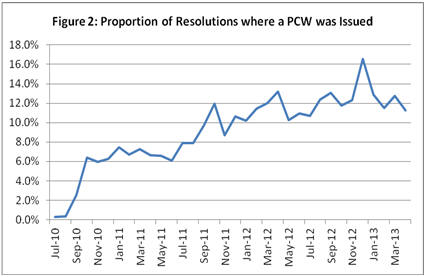Impact on Policing
Impact on Policing
Operationally, PCWs are more suited in urban rather than rural areas, and in particular the centres of larger localities with prevalent disorder or alcohol-related offending. The initiative targets those 17-30 years of age (highest rates of overall offending are in this age group, including for the key offences eligible for PCWs). Of the top five offences where PCWs are most commonly used, four have no victims (and are “Police initiated”, such as Possession of Cannabis or Disorderly Behaviour). Shoplifting under $500 is the only offence often resolved with a PCW with a recorded victim.
Figure 1 below shows PCWs’ significant contribution to reducing the number of prosecutions undertaken by Police in recent years. Figure 2 shows the growth in the use of PCWs since their introduction in 2010. The proportion of resolved offences where a PCW was issued has risen to over 10%. The spikes in Figure 2 are attributable to seasonal factors, such as summer holidays, warmer weather and the Rugby World Cup in late 2011, when Breach of Liquor Ban and Disorderly Conduct, for instance, are more prevalent.


PCWs provide Police staff with an avenue to intervene sooner where someone is intoxicated and causing problems. They can, for example, be more easily removed from a situation by being arrested and issued with a PCW, but without the “over the top” consequences of being charged and processed through the justice system. A PCW:
- is not a criminal conviction
- is held in Police records and will be considered if the person commits another offence
- will not show up when employers seek information on a prospective employee’s offending history.